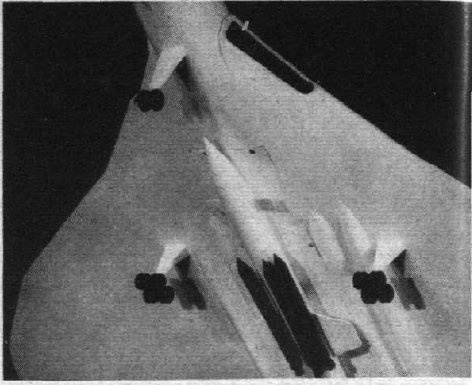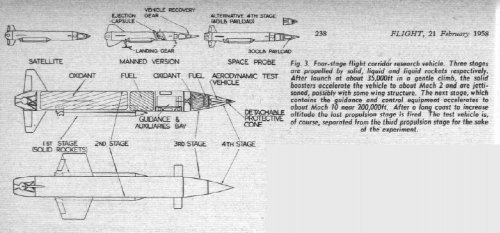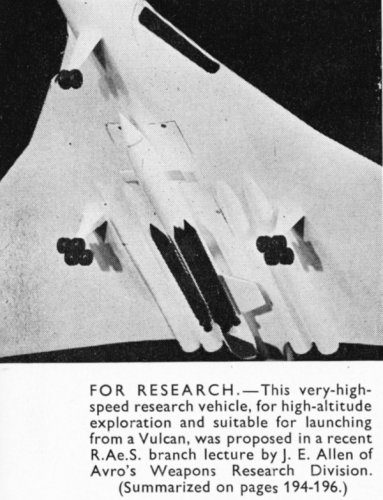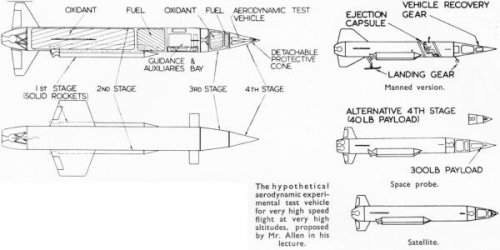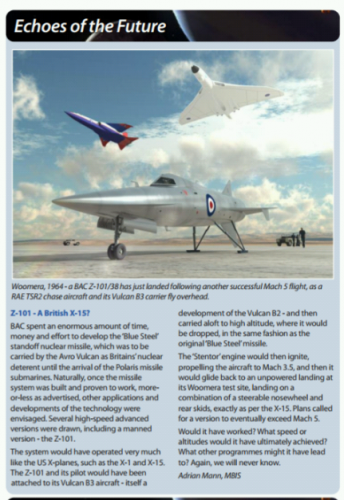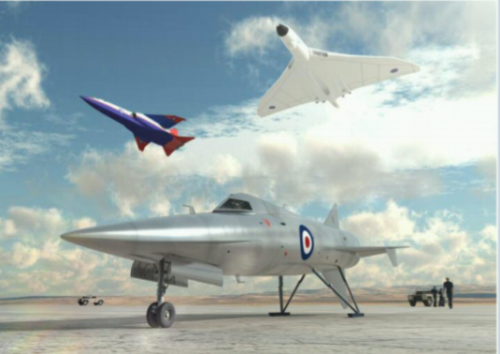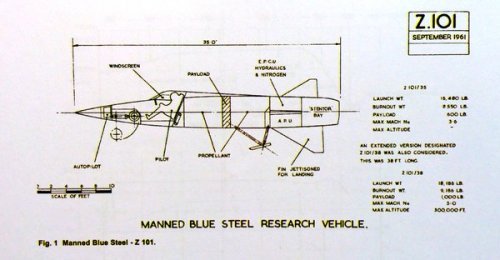From the current issue of the British Interplanetary Society’s Space Chronicles.
Based on studies of manned Blue Steel to do the same research as the X-15
The Vulcan Obiter Z 124
By October 1962 ambitions had increased to the extent of considering a brand new rocket vehicle completely different in principal from Blue Steel. The concept began with the recognition that the Vulcan, because of its delta wing, had very tall undercarriage. This would permit the installation of a large ballistic multi-stage rocket weighing up to 40,000lb (the drawing shows the missile hanging outside the bomb bay which appears to have had the doors removed). This would be carried and air launched much as was Blue Steel, from a height of about 50,000ft, but the trajectory would be more akin to that of the ballistic Skybolt as the obiter was wing-less. It was calculated that this three-stage vehicle could place a 650lb payload into a low earth orbit. Although less design detailing was done on the obiter than on the manned Blue Steel its potential was recognised. Here was a revolutionary way of placing application satellites (for communications, meteorology, survey, navigation etc) in orbit launched from a mobile platform. Two advantages sprang from this: firstly the Vulcan could fly to any base in Europe, collect its rocket and launch into a variety of orbital planes; secondly, with flight refuelling, the craft could be placed in an equatorial orbit. In this way Europe could have had its very own launching system, quite different from that of the USA, which was totally expendable.
This project was announced at a lecture and received a lot of publicity. Whether it was ever considered seriously by HMG is doubted but it could have given the RAF an opportunity to take a bold step, into spaceflight.
Based on studies of manned Blue Steel to do the same research as the X-15
The Vulcan Obiter Z 124
By October 1962 ambitions had increased to the extent of considering a brand new rocket vehicle completely different in principal from Blue Steel. The concept began with the recognition that the Vulcan, because of its delta wing, had very tall undercarriage. This would permit the installation of a large ballistic multi-stage rocket weighing up to 40,000lb (the drawing shows the missile hanging outside the bomb bay which appears to have had the doors removed). This would be carried and air launched much as was Blue Steel, from a height of about 50,000ft, but the trajectory would be more akin to that of the ballistic Skybolt as the obiter was wing-less. It was calculated that this three-stage vehicle could place a 650lb payload into a low earth orbit. Although less design detailing was done on the obiter than on the manned Blue Steel its potential was recognised. Here was a revolutionary way of placing application satellites (for communications, meteorology, survey, navigation etc) in orbit launched from a mobile platform. Two advantages sprang from this: firstly the Vulcan could fly to any base in Europe, collect its rocket and launch into a variety of orbital planes; secondly, with flight refuelling, the craft could be placed in an equatorial orbit. In this way Europe could have had its very own launching system, quite different from that of the USA, which was totally expendable.
This project was announced at a lecture and received a lot of publicity. Whether it was ever considered seriously by HMG is doubted but it could have given the RAF an opportunity to take a bold step, into spaceflight.

